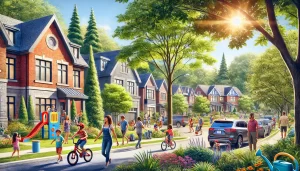It’s smaller and less bold, but the SmartTrack plan is still around.
Now dubbed “the SmartTrack stations program”, the plan includes fewer stations and less frequent service than Mayor John Tory’s first mayoral campaign team envisioned it. However, this week, Toronto City Council voted in favour of revising the “Ontario-Toronto Agreement in Principle” to include the program.
Under the revised agreement, the City will fund the construction of five new GO Transit stations in Toronto:
- Finch – Kennedy station on the Stouffville line;
- East Harbour station on the Lakeshore East and Stouffville lines;
- King – Liberty and St Clair – Old Weston stations on the Kitchener line; and
- Bloor – Lansdowne station on the Barrie line.
 Map of SmartTrack and other new GO Transit stations in Toronto. Image, Metrolinx
Map of SmartTrack and other new GO Transit stations in Toronto. Image, Metrolinx
The Province of Ontario or its agencies, Metrolinx and Infrastructure Ontario, will identify contractor teams to build the five stations and manage the construction projects. Metrolinx would also seek to create partnerships with private developers to help fund all or some of the construction costs through its Transit-Oriented Communities scheme.
The new stations will now be part of the Metrolinx GO Expansion program, meaning that GO trains would likely only operate through the new stations about every 15 minutes during rush hours—a far cry from the subway-like frequency Mayor Tory originally promised.
The City has agreed to drop two stations from SmartTrack, due to their proximity to future subway stations that are part of Ontario’s proposal to develop several rapid-transit lines in Toronto. According to an Ontario news release, “The SmartTrack Stations Program has been updated to reflect the Province’s ongoing work to build the Ontario Line and Scarborough Subway Extension priority transit projects. These two priority subway lines include stations that will provide improved, higher frequency subway service for the communities and riders served…” by the original SmartTrack proposal. The City is removing the Lawrence – Kennedy station from the plan because it’s close to the site of the future Lawrence East station on an extension of the Toronto Transit Commission’s Line 2 subway. The future Gerrard Station on the Ontario Line would have shared the same site as the original Smart-Track Gerrard – Carlaw station.
But, the new version of SmartTrack now includes the Bloor – Lansdowne station, which Metrolinx had already proposed building. This change means that the City, rather than the Province, pays for its construction.
In a report to Council, City staff write, “The stations will integrate with the existing and planned transit network, providing a greater choice of route options for transit riders. The five new stations will connect with four existing or planned higher-order transit lines (including subway lines and streetcars in dedicated rights-of-way) as well as nine local transit services. The stations will provide improved access to more than 52 major regional destinations located within 800 metres of transit stations that generate a significant volume of transit trips, including major shopping centres, recreational opportunities, community facilities, and educational institutions. Forecast ridership varies station-by-station, with some stations attracting a greater number of transit riders than others. In total, the five stations are projected to attract a combined 24,000 boardings and alightings during the average weekday peak hour. Taken together, the five new stations are projected to attract 3,400 new daily riders to Toronto’s transit system by 2041 every weekday. Ridership would likely be higher with full fare integration between the TTC and GO Transit.”
* * *
 In 2014, candidate John Tory presented this plan for SmartTrack as part of his mayoral-campaign platform, image: John Tory campaign
In 2014, candidate John Tory presented this plan for SmartTrack as part of his mayoral-campaign platform, image: John Tory campaign
In a public announcement on May 27, 2014, Toronto mayoralty candidate John Tory unveiled his “SmartTrack” plan for a “surface subway” to run on GO Transit rail corridors. The future mayor claimed that the $8-billion line would be operating in seven years. The mayor also proposed charging potential passengers TTC fares to attract as many riders as possible and relieve pressure on TTC services.
Originally, the SmartTrack route would have extended from Toronto Pearson International Airport to Union Station, east into Scarborough and north to Unionville in York Region with 22 new stops, mostly on GO tracks. However, the plan also suggested heavy-rail trains along Eglinton Avenue West from Mount Dennis at the end of the Crosstown LRT line to the airport and a future transit hub there.
After Tory’s successful run for mayor, the plan began to devolve. Council agreed to remove the Eglinton West component and replace it with the future Eglinton West light rail extension west of the future Mount Dennis LRT / GO station.
In 2016, the Province and the City established principles with respect to cost-sharing on SmartTrack and other transit-expansion initiatives. In April, 2018, City Council approved a contribution of as much as $1.463 billion towards the program and requested Metrolinx to proceed with procurement. The Province subsequently halted the stations’ procurement in December, 2018 with the intention of having delivering them through a market-driven transit-oriented development delivery strategy.
* * *
 Map of the future Finch – Kennedy GO Station, image, Metrolinx
Map of the future Finch – Kennedy GO Station, image, Metrolinx
Finch – Kennedy Station will be built on the north side of Finch Avenue East, about halfway between Kennedy Road and Midland Avenue. The plan includes a “road-rail grade separation”–a bridge–allowing road vehicles to pass under the rail corridor. Four entrances at each corner of the bridge provide access to the station’s two side platforms, on both sides of the rail corridor. Each entrance includes stairs, elevators, and bicycle parking facilities, connecting to multi-use paths and future bike lanes on Finch. Motorists can access the station along a new access road across from Baylawn Drive, about 230 metres east of the rail corridor. TTC buses will connect with the station at stops in lay-bys on both sides of Finch. There is potential for future development in the area of the station.
Since 2018, the City has changed its plans for the station by:
- deferring construction of the northern entrance road from Silver Star Boulevard and the northern station entrance and tunnel to a future phase;
- relocating an accessible passenger pick-up / drop-off facility (or “kiss and ride”) to the southern station access road at Finch on the east side of the station; and
- narrowing the grade separation, allowing planners to reduce the length of the rail bridge span.
 Map of the future East Harbour GO Station, image, Metroliinx
Map of the future East Harbour GO Station, image, Metroliinx
East Harbour Station will lie between the Don Valley Parkway and Eastern Avenue, at the crossing of the future Broadview Avenue extension. Metrolinx and its partner will build the station as an integrated transit hub with the Ontario Line’s East Harbour Station. Passengers enter the station at six sites, three on each side of the rail corridor, connecting to passageways under the rail corridor, which, in turn, provide stair and elevator access to the platforms. Pedestrian bridges on both sides of the rail corridor cross the Don Valley Parkway and Don River, providing direct access to the Lower Don Trail on the west side of the river, and to the West Don Lands (Canary District) neighbourhood and future Keating Precinct. The centre entrances to the station connect passengers to the future Broadview streetcar.
Metrolinx will produce the station through the Transit-Oriented Communities program with a third party, the developer of the East Harbour project. Under this approach, the third party will design and deliver the station. East Harbour Station contributes the highest ridership of all SmartTrack stations, with planners projecting 13,000 rush-hour boardings and alightings in 2041
The design of the station has changed since 2018 by:
- integrating the station with the Ontario Line station in a “transit hub” with shared station amenities;
- widening the Broadview underpass and rail bridge to accommodate the extra tracks for the Ontario Line. (The City will defer opening of the Broadview Avenue extension through the underpass until after the station is complete.);
- integrating the pedestrian and cycling bridge across the Don River, providing access to Corktown Common and communities to the west, into the Ontario Line rail bridge; and
- building a new road from Eastern Avenue on the north side of the station for corridor maintenance and emergency vehicles.
 Map of the future King – Liberty GO Station, image, Metrolinx
Map of the future King – Liberty GO Station, image, Metrolinx
King – Liberty Station is on the north side of King Street West, between Joe Shuster Way and Sudbury Street. The station will have an entrance on King Street West, immediately west of the rail corridor, providing access to an elevated pedestrian bridge that connects the two island platforms. The station includes stairs and two elevators at the King Street West entrance structure to and from the pedestrian bridge and the platforms. A second entrance, including a second pedestrian-cycling bridge, will stand between Sudbury Street and Joe Shuster Way. The station will also offer cyclists bike parking.
Planners expect the King – Liberty Station to attract 3,200 peak-period passengers in 2014, the second-highest ridership number of all SmartTrack stations.
The City has altered its 2018 design by:
- deferring construction of the main station building on Sudbury Street to a future phase.;
- reconfiguring platforms to provide better access to the entrance on King Street West.
- changing platforms from side platforms to island platforms to serve four Kitchener-line tracks.
 Map of the future St. Clair – Old Weston GO Station, image, Metrolinx
Map of the future St. Clair – Old Weston GO Station, image, Metrolinx
The SmartTrack plan will situate St Clair – Old Weston Station on the north side of St Clair Avenue West, about halfway between Keele Street and Old Weston Road.
Two station entrance buildings on Union Street on the east side of the rail corridor will provide pedestrian access to two side platforms through a tunnel under the rail corridor. One stair and elevator connection will connect each tunnel to each platform. Union Street can be accessed from St Clair Avenue West via Old Weston Road and Townsley Street. The station offers more access to pedestrians directly to the south end of the southbound platform from St Clair Avenue West, and to the north end of the southbound platform from Weston Road along a pedestrian path at the end of Gunns Road. A curbside pick-up / drop-off zone on the west side of Union Street provides vehicular access. A bus loop off Union Street between the two station buildings will accommodate TTC bus service and Wheel-Trans pick-up / drop-off.
The City is co-ordinating the development of St Clair-Old Weston Station with the St Clair Avenue West Area Transportation Master Plan (TMP). It expects the station project to include widening of St Clair Avenue West widening and extending Gunn’s Road, as the TMP recommends. The City also plans to extend Davenport Road to connect with Union Street. The station will attract the fewest riders of all these stations, about 300 during rush hours in 2041.
Since 2018, the City has changed the station design by adding more space for the Canadian Pacific Railway tracks on the east side of the rail corridor, requiring it to redesign the bridge for the future Davenport Road extension.
 Map of the future Bloor – Lansdowne GO Station, image, Metrolinx
Map of the future Bloor – Lansdowne GO Station, image, Metrolinx
Bloor – Lansdowne Station will be located on the south side of Bloor Street West, west of Lansdowne Avenue. The station will have a side platform configuration, with southbound platforms on the west side of the rail corridor and northbound platforms on the east side. An entrance building will stand on the east side of the rail corridor at Bloor Street West, providing pedestrian access to the station. Stairs and elevators at the entrance will provide access to a passageway under the rail corridor, also connecting to the north end of the platforms above with more stairs and elevators. Another pedestrian access to the south end of the southbound platform will be available from Sterling Road; in the future, this could connect to the south end of the northbound platform through a second tunnel.
Since 2018, the City has made several changes to the station design:
- integrating the main station building into the Bloor Street grade separation;
- deferring the southern access tunnel, stairs and elevators to a future phase;
- deferring the pedestrian bridge over Bloor Street West to a future phase; and
- deferring the multi-use path east of and parallel to the rail corridor to a future phase.
The City and Metrolinx intend to create a transit-oriented community project to support the station construction.
* * *
The price tag for these five stations remains at $1.463 billion, including $1.195 billion for base station infrastructure and $268 million for City-initiated station requirements, including acquiring land and building amenities such as pedestrian walkways and overpasses, landscaping, bike parking and more.
The Government of Canada has committed to provide $8.3 billion to fund public transit in Ontario over the next 10 years through its Investing in Canada Plan – Public Transit Infrastructure Fund. Ontario is allocating about $4.9 billion of this money to Toronto, due to the high number of transit passengers in the city. City Council has already identified the SmartTrack Stations Program as a priority project for these federal dollars. Ontario and Toronto will work together to apply to the federal government for the SmartTrack program to receive this funding. For any project it approves, the federal government will fund as much as 40 percent of eligible costs which, in the case of the SmartTrack program, is $585 million.
* * *
You may add your comments on the project in the space provided on this page, or join the discussion in our dedicated Forum thread.
* * *
UrbanToronto has a new way you can track projects through the planning process on a daily basis. Sign up for a free trial of our New Development Insider here.
















